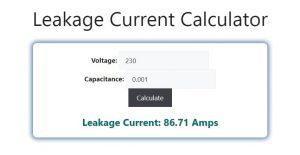About Leakage Current Calculator (Formula)
A Leakage Current Calculator is a valuable tool used to estimate the small electrical currents that flow unintentionally in an electrical circuit due to insulation resistance or stray capacitance. Leakage current is critical to monitor in many electronic devices and systems, particularly in power supplies, medical equipment, and industrial applications, as it can cause unwanted energy loss or even pose safety risks.
Formula
The formula for calculating leakage current (LC) is:
Leakage Current (LC) = 377 * Voltage * Capacitance
Where:
- Voltage is the applied electrical voltage (in volts) across the component.
- Capacitance is the capacitance (in farads) of the component causing leakage.
- 377 is a constant derived from the angular frequency of an AC circuit (2 * π * 60 Hz).
How to Use
Using the Leakage Current Calculator is straightforward:
- Measure the Voltage: Obtain the voltage applied across the circuit or component.
- Record the Capacitance: Measure the capacitance value of the circuit, usually in microfarads (µF).
- Enter Values: Input these values into the calculator.
- Calculate: The calculator will then provide the leakage current value, typically in amperes (A).
Example
Let’s assume a circuit has a voltage of 230 volts and a capacitance of 0.001 µF (microfarads). Using the formula:
Leakage Current = 377 * 230 * 0.001
Leakage Current = 86.71 microamperes (µA)
This means that the leakage current in this circuit is approximately 86.71 µA.

FAQs
- What is leakage current?
Leakage current refers to the small current that flows through an insulating material or a component, typically caused by imperfections in insulation or stray capacitance. - Why is leakage current important?
Monitoring leakage current is crucial for safety, as excessive leakage can lead to energy waste, overheating, or electrical hazards. - What are typical sources of leakage current?
Common sources include insulation breakdown, stray capacitance, and imperfections in electronic components. - Is leakage current dangerous?
In some applications, such as medical devices or sensitive electronics, leakage current can pose a safety risk. Excessive leakage in high-voltage systems can be hazardous. - How can I reduce leakage current?
To reduce leakage current, use high-quality insulating materials, reduce the operating voltage, or optimize circuit design to minimize stray capacitance. - What units are used for capacitance in the formula?
Capacitance is usually measured in farads, but in practical calculations, microfarads (µF) are commonly used. - What does the constant 377 represent?
The constant 377 is derived from the angular frequency in an AC circuit (2 * π * 60 Hz), where 60 Hz is the standard frequency in most power systems. - How accurate is the leakage current calculation?
The calculation provides a good estimate of leakage current but may vary based on the exact characteristics of the insulation or components used. - Can leakage current occur in DC circuits?
Leakage current is more prominent in AC circuits due to stray capacitance, but small amounts of leakage can occur in DC circuits due to insulation breakdown. - What happens if the leakage current is too high?
Excessive leakage current can lead to energy loss, potential damage to components, overheating, and safety hazards in electrical systems. - What is stray capacitance?
Stray capacitance refers to unintended capacitance between conductive elements in a circuit, leading to leakage currents. - How is voltage related to leakage current?
Higher voltages tend to increase leakage current since the electric field across the insulating material becomes stronger. - How do I measure capacitance?
Capacitance can be measured using a capacitance meter, which is commonly available in multimeters. - Can leakage current cause electrical shock?
In some cases, especially in medical or sensitive equipment, high leakage current can cause electrical shock or affect device performance. - What industries rely on leakage current calculations?
Industries such as electronics manufacturing, telecommunications, healthcare, and power systems use leakage current calculations to ensure safety and performance. - Does insulation resistance affect leakage current?
Yes, insulation resistance plays a critical role. Lower insulation resistance typically leads to higher leakage current. - Can weather conditions affect leakage current?
Yes, factors such as humidity and temperature can affect insulation materials, leading to fluctuations in leakage current. - What types of equipment can benefit from using a leakage current calculator?
Power supplies, transformers, medical equipment, and industrial machinery can all benefit from regular leakage current monitoring to prevent failures. - How does frequency affect leakage current?
Leakage current is directly proportional to frequency, meaning that higher frequency AC systems will have higher leakage current for the same capacitance and voltage. - How can I prevent leakage current in electronic circuits?
Use proper insulation, choose components with low parasitic capacitance, and ensure circuit design is optimized for minimal leakage.
Conclusion
A Leakage Current Calculator is an essential tool for calculating the small currents that flow unintentionally in an electrical circuit due to stray capacitance or insulation imperfections. By understanding the formula and how to use the calculator, engineers and electricians can monitor and control leakage current, ensuring system safety and efficiency.
